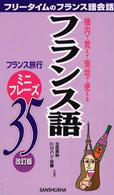Full Description
Building on existing analytical frameworks, this book provides a new methodology allowing different language policies in international multilingual organisations (or "language regimes") to be compared and evaluated on the basis of criteria such as efficiency and fairness. It explains step-by-step how to organise the evaluation of language regimes and how to design and interpret indicators for such evaluation. The second part of this book applies the theoretical framework to the evaluation of the language policy of the Patent Cooperation Treaty (PCT) division of the World Intellectual Property Organisation (WIPO) and the European Patent Office (EPO). Results show that an increase in linguistic diversity of the language regimes of patent organisations can both improve the efficiency of the patent system and lead to a more balanced distribution of costs among countries. This book is a resource for scholars in language policy and planning and for policy-makers in the international and European patent system.
Contents
1. List of figures; 2. List of tables; 3. List of abbreviations; 4. Acknowledgements; 5. Introduction; 6. Setting the scene: Language policy and evaluation; 7. Chapter 1. The need for evaluation in language policy; 8. Part I. Theory: From economic analysis to multilingual communication; 9. Chapter 2. The criteria of efficiency and fairness; 10. Chapter 3. Multilingual communication as an object of evaluation; 11. Chapter 4. The evaluation process; 12. Chapter 5. Indicators; 13. Part II. Application to multilingual patent organisations; 14. Chapter 6. Multilingualism and patents; 15. Chapter 7. The language regime of the PCT system; 16. Chapter 8. The language regime of the EPO; 17. Conclusions; 18. Chapter 9. Summary and perspectives; 19. Annexes and bibliography; 20. Appendices; 21. References; 22. Index





